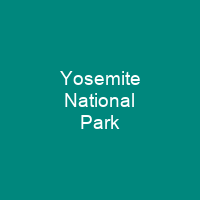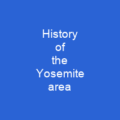Yosemite National Park, a Gem in California’s Crown
Imagine stepping into a world where nature’s grandeur meets human history—welcome to Yosemite National Park! Nestled in the heart of California, this majestic park covers 759,620 acres and borders Sierra and Stanislaus National Forests. Designated as a World Heritage Site in 1984, it stands as a testament to the awe-inspiring beauty of nature’s creation.
The Name and History
But how did this park get its name? The term ‘Yosemite’ comes from the Miwok language, meaning “they are killers.” This intriguing name was given to the Ahwahneechee People, an indigenous tribe that once called this land home. These people were a distinct culture with their own unique traditions and way of life.
The Early Days
Yosemite played a pivotal role in shaping the concept of national parks. In 1864, President Abraham Lincoln signed the Yosemite Grant, declaring the valley as federally preserved land. This was followed by John Muir’s successful campaign to establish Yosemite Valley as a National Park in 1890.
The Native American Legacy
Before European settlers arrived, the Ahwahneechee people thrived here. However, the arrival of the California Gold Rush in 1848-1855 drastically changed their lives. This event drew over 90,000 European Americans to the area, leading to significant conflicts and a rapid decline in the indigenous population.
The Mariposa War
One of the most tragic events was the Mariposa War, which began as retaliation against the extermination and domestication of their people. In 1850, James Savage led a group that attacked the Ahwahneechee, leading to a series of battles and ultimately the forced relocation of many Native Americans from Yosemite.
Preservation and Tourism
Despite these challenges, the park’s natural beauty continued to attract visitors. In 1855, James Mason Hutchings and Thomas Ayres visited Yosemite, sparking a wave of tourism that has only grown over time. Today, it attracts around four million visitors annually, making it one of the most popular national parks in the USA.
The Ahwahneechee’s Survival
While many Native Americans were forced to relocate or adapt, some managed to survive and even thrive within the park’s boundaries. They learned to live within the new environment by entering the tourism industry through employment and small businesses, manufacturing and selling goods and providing services.
The Natural Wonders
Yosemite’s natural wonders are breathtaking. The park features thousands of lakes and ponds, over 1,600 miles of streams, and 350 miles of roads. It contains three adjacent wilderness areas and two federally designated Wild and Scenic Rivers. The Tunnel View offers a stunning view of the valley with El Capitan and granite domes like Sentinel Dome and Half Dome prominently featured.
Glaciers and Ecosystems
The park’s landscape has been shaped by millions of years of geological processes, including glaciation. Many Yosemite glaciers have disappeared due to climate change, but the Lyell and Maclure glaciers are expected to follow suit. The park supports a diverse range of habitats, from scrubby chaparral to vast expanses of granite at treeline.
Conservation Efforts
John Muir played a crucial role in protecting Yosemite National Park. He popularized the area through articles and scientific papers, ensuring that many parks remained untouched. The National Park Service (NPS) was formed in 1916, transferring control of Yosemite to its jurisdiction.
The NPS Impact
While the NPS completed infrastructure projects like roads, lodges, and campgrounds, it also had negative impacts on Native American residents. The park’s cultural expression was restricted, leading to the destruction of an indigenous village in 1969. Today, efforts are ongoing to preserve the park’s natural beauty while honoring its rich history.
Future Challenges
The challenges facing Yosemite today include climate change, loss of natural fire regimes, exotic species, air pollution, habitat fragmentation, and more. Despite these threats, initiatives like prescribed fires and DNA sampling of bears are helping to manage the park’s ecosystems.
Conclusion
Yosemite National Park is not just a place of breathtaking beauty; it’s a living testament to human history and our ongoing efforts to preserve nature. As we continue to face new challenges, let us remember the lessons of the past and work towards a sustainable future for this incredible natural wonder.

You want to know more about Yosemite National Park?
This page is based on the article Yosemite National Park published in Wikipedia (retrieved on March 2, 2025) and was automatically summarized using artificial intelligence.







